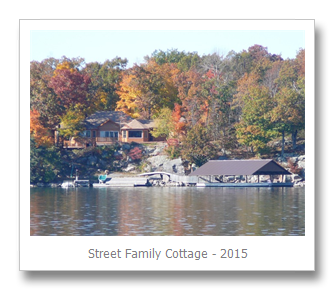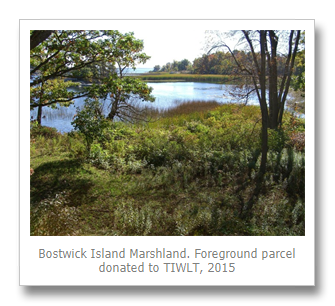Written by
Sandra Tassel posted on June 13, 2016 12:33
Canadian and American family history is intertwined with Thousand Islands history, for Bob and Paula Street. They are the third generation that has spent summers on The River. It is now a cherished tradition for their grown children. Their grandchildren, the fifth generation, seem just as drawn to the beloved family cottage and surrounding woods and waters. In order for their family to have a future in the Thousand Islands, Bob and Paula had to find a financially realistic way to pass it down, before they pass away.
The land that is the object of their affection, and the location of their memories, has passed down through the generations along with the photo albums and other mementoes. But this transition, from Bob and Paula to their children, has required many conversations, much thought about numerous alternatives and extensive planning.
Without that effort they might have left their heirs with the beautiful, sun-filled cottage, extensive forest and a large wetland—along with a whopping Canadian capital gains tax liability. Their heirs would have to seriously consider selling some of the property to pay the tax, which would have surely led to development of land that is so dear to them.

Bob and Paula were facing a dilemma that is familiar to many families with a place on The River. Land here has appreciated in value substantially during their lifetimes. Most Canadians are aware that they, or their estate, will owe Capital Gains tax of roughly 25% on that appreciation when they sell or even give their cottage to their heirs, or anyone else. For most Americans, like Bob and Paula, this is often a big surprise because US taxation of estates is entirely different and capital gains taxes are due only when property is sold. But the Canadian tax is due on all family transfers by Americans, even between spouses, and they have to decide whether or not to also report the gain on their US income tax returns where in-family transactions are normally not reported. The Canada-US tax treaty has provisions to eliminate double taxation. There are other dimensions to the problem and although Bob and Paula didn’t consider them all, they are willing to share their experiences with other US taxpayers who own Thousand Islands properties and are facing similar issues. And they believe for most, there is a sense of urgency, since the Canadian tax is an ever growing tax liability.

It turned out for Bob and Paula that a significant part of their solution was donating a portion of their land to the Thousand Islands Watershed Land Trust (TIWLT) to be held for conservation in perpetuity.
They acknowledge that at first it may have seemed counter-intuitive that keeping a property in one’s family, is achieved by giving some of it away, rather than selling it to raise money to pay the Canadian taxes and having it developed by others. But Bob’s assessment of the alternatives demonstrated that the monetary bottom-line made sense. More importantly, the emotional calculus produced the desired result of protecting the ecologically sensitive areas of the land, their family had stewarded for generations.
As US taxpayers, Bob and Paula considered making their gift to American Friends of Canadian Land Trusts (American Friends) in order for their appraised value of the land donation to be tax deductible in the US. American Friends is a US charity whose mission is the preservation of Canada’s natural heritage. The Canadian government granted American Friends special tax status in Canada, so gifts of land, or interests in land, are effectively not subject to the Canadian capital gains tax.
However, because Bob and Paula’s proposed donation included a significant marshy wetland, it qualified for Canada’s generous Ecological Gifts Program. Although that program does not provide US tax benefits, it provided a reasonable tax outcome for Bob and Paula when paired with the taxable transfer of their cottage within the family, and it involved local stewardship of the donated property, by TIWLT from day one, an organization and staff whom Bob & Paula have known for years.
Opening their cottage this season feels a little different to Bob and Paula. They are experiencing the joy of knowing they created a nature preserve for the benefit of everyone who loves The River and all the birds and wildlife that depend on the wetlands. And they are comforted by the knowledge that they created a legacy that will allow their family to have a place in the islands in the future.
|
You are invited to learn how conservation can help you keep your land for the next generation
Venue: Bob & Paula Street’s Bostwick Island Cottage, Admiralty Islands.
Saturday, July 30, 2016 9:00 AM-11 AM
Representatives from TIWLT, American Friends and a Canadian accountant will explore the issues and opportunities.
Please contact info@tiwlt.ca to register or 613-659-4590
This is your opportunity to understand more about advantages to your family if you:
- Have ecologically significant land in addition to the 1 hectare cottage property of at least 1 hectare.
- Are considering selling your cottage.
- Want to give your cottage to your heirs.
- Hope to keep your cottage experience intact, with reduced property taxes.
- Value Thousand Islands’ wild habitat and beautiful natural views.
- You want the Thousand Islands to continue to have wild habitat and beautiful natural views.
If you fit the above description, please join us for this enlightening event!
http://www.tiwlt.ca (TIWLT) https://www.afoclt.org (American Friends) http://www.ec.gc.ca/pde-egp (EcoGift Program)
|
By Sandra Tassel, American Friends of Canadian Land Trusts
Sandra Tassel is a conservation professional based in Washington State. She works with American Friends of Canadian Land Trusts, assisting its Canadian partner organizations and helping landowners from the U.S. to protect their properties. Sandra is the author of “The Conservation Program Handbook”, published by Island Press, and numerous articles and papers on topics related to preservation of important natural, cultural and recreational resources.